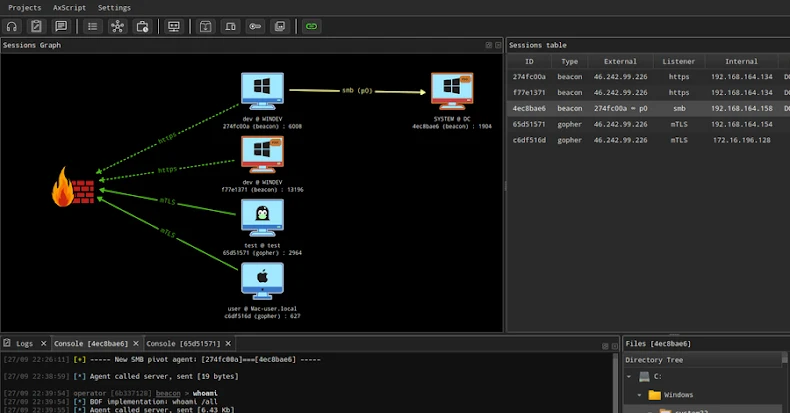Russian Ransomware Gangs Exploit Open-Source AdaptixC2 for Sophisticated Cyber Attacks
In recent developments, the open-source command-and-control (C2) framework known as AdaptixC2 has been increasingly utilized by cybercriminals, notably Russian ransomware groups, to orchestrate advanced cyber attacks. Originally designed for penetration testing, AdaptixC2 offers a suite of features that have been co-opted for malicious purposes.
AdaptixC2: A Dual-Edged Sword
AdaptixC2 is an extensible post-exploitation and adversarial emulation framework. Its server component is developed in Golang, while the graphical user interface (GUI) client is crafted using C++ QT, ensuring cross-platform compatibility. The framework boasts fully encrypted communications, command execution capabilities, credential and screenshot management, and a remote terminal, among other functionalities.
The initial public release of AdaptixC2 occurred in August 2024, spearheaded by a GitHub user named RalfHacker (also known as @HackerRalf on X). Self-described as a penetration tester, red team operator, and malware developer, RalfHacker’s creation was intended for ethical hacking and red teaming exercises.
Malicious Adoption by Threat Actors
Despite its ethical origins, AdaptixC2 has been co-opted by various hacking groups. Notably, threat actors associated with the Fog and Akira ransomware operations have integrated the framework into their attack methodologies. Additionally, an initial access broker has employed AdaptixC2 in conjunction with CountLoader to deploy various post-exploitation tools.
Palo Alto Networks’ Unit 42 provided an in-depth analysis of AdaptixC2, highlighting its modular and versatile nature, which allows comprehensive control over compromised machines. The framework has been exploited in schemes such as fake help desk support calls via Microsoft Teams and through AI-generated PowerShell scripts.
Investigations and Implications
Cybersecurity firm Silent Push initiated an investigation into AdaptixC2 following the discovery of RalfHacker’s GitHub bio, which identified them as a MalDev (malware developer). This led to the identification of multiple email addresses linked to the GitHub account and a Telegram channel named RalfHackerChannel, boasting over 28,000 subscribers. This channel disseminates messages from a dedicated AdaptixC2 channel, indicating a significant following and potential influence within the cyber community.
In August 2024, a message on the AdaptixFramework channel revealed intentions to develop a public C2 framework akin to Empire, another well-known post-exploitation and adversary emulation tool. While there is no direct evidence linking RalfHacker to malicious activities involving AdaptixC2 or CountLoader, the association with Russia’s cybercriminal underground, the use of Telegram for promotion, and the framework’s adoption by Russian threat actors raise substantial concerns.
The Broader Context of Open-Source Tools in Cybercrime
The exploitation of open-source tools like AdaptixC2 by cybercriminals underscores a growing trend in the cybersecurity landscape. Open-source software, by its nature, is accessible to anyone, including malicious actors who can repurpose these tools for nefarious activities. This dual-use dilemma presents challenges for the cybersecurity community, as tools designed for ethical purposes can be weaponized, complicating efforts to distinguish between legitimate and malicious use.
The Role of Initial Access Brokers
Initial access brokers (IABs) play a pivotal role in the cybercrime ecosystem. These entities specialize in breaching networks and selling access to other cybercriminals, including ransomware operators. The integration of AdaptixC2 by IABs, in conjunction with loaders like CountLoader, facilitates the deployment of post-exploitation tools, streamlining the process for subsequent malicious activities.
The Ethical Hacker’s Dilemma
For developers like RalfHacker, the unintended misuse of their tools poses an ethical quandary. While the intention behind creating frameworks like AdaptixC2 is to aid in strengthening cybersecurity defenses through penetration testing and red teaming, the potential for misuse is ever-present. This situation highlights the need for developers to consider the broader implications of their creations and the importance of implementing safeguards to prevent misuse.
Conclusion
The appropriation of AdaptixC2 by Russian ransomware gangs exemplifies the complex interplay between open-source development and cybercrime. As threat actors continue to exploit tools designed for ethical purposes, the cybersecurity community must remain vigilant, fostering collaboration and innovation to stay ahead of malicious entities.



